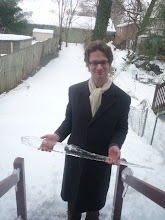Alchemical Horror Stories through the Ages
And some that were modest successes
By Nathan Turowsky
Attempts to create homunculi (artificial foeti)
Phillipus Theophrastus Aureolus Bombastus von Hohenheim (1493-1541), who called himself Paracelsus, tried to make a homunculus out of beer, milk, and his own tears. When it failed, he added a highly poisonous chemical called cinnabar, which turned the mixture into what was essentially poisonous Marmite. Paracelsus then saw a toad licking the mixture, briefly thought that he had created a homunculus, realised his mistake when the toad died, and then died from mercury poisoning himself. He also first got the idea of distinguishing between different illnesses (i.e. assuming that cancer and bubonic plague were, in fact, different things) and discovered the element zinc. All in all, he was not a total waste of air.
Johanna Habsmun Riga (1330-1400), a female Swiss alchemist, somehow got it into her head to try to create fourteen homunculi, each corresponding to an Aristotelian or Gregorian virtue or sin. She claimed at one point to have successfully created all except for ‘Moderation.’ After her death, the Inquisition raided her house, finding a dead tortoise labelled ‘Sloth’ and a starving rooster labelled ‘Pride.’ They then set about systematically expunging all references to Riga from history. They failed at this, but thanks to their efforts, little is known about her life.
David Christianus (1684-1749) recommended poking a hole in an egg, replacing some of the white with semen (presumably one’s own), resealing the egg, burying it in soft dung for three weeks during March, and waiting for a retarded child to appear in one’s garden eating lavender and earthworms.
Johann Wolfgang von Goethe (1749-1832), the great German writer, reported a case to the authorities in which one of his friends stole various body parts from dead animals, sewed them together into a vaguely human form, and shocked it with a Leyden electrical jar until it fell apart.
Attempts to create a Philosopher’s Stone
Paracelsus’s escapade with the toad was actually part of an extended effort to purify alcahest, supposedly the substance of which the Philosopher’s Stone was composed. As noted, he ended up with poisonous Marmite, which killed him.
Mary the Jewess (third century, dates uncertain) was responsible for the invention of alchemy. After trying to create a basilisk without success, she turned her attention to making a Philosopher’s Stone out of emeralds. She ended up with a more useful substance than Paracelsus, namely a distillation chamber filled with vegetable broth. This was the first distillation chamber ever built.
Louis Pasteur (1822-95), the French chemist, was briefly interested in making a Philosopher’s Stone out of milk, a la Paracelsus. It failed, but the milk ended up pasteurised. The next year, he conclusively proved that homunculi did not exist.
Nicolas Flamel (1330-14??), a contemporary of Johanna Riza, was a wealthy French scrivener, or preparer of legal documents. He is supposed to have created a Philosopher’s Stone out of plague pustules, which he used to become fabulously wealthy and live for a hundred and sixty-two years. It is possible possible possible that he was one of a tiny population who developed an immunity to the plague through close contact with certain dyes used in linen-drapery, which reacted as a preservative in his body and allowed him to live to a fantastic age. He was certainly still alive in 1417, and possibly in 1428 and 1440 as well.
Perenelle Flamel (1341-14??), Nicolas’s wife, allegedly made her own Stone out of scabs and gunpowder. She was exposed to the same dyes as her husband, which may mean that she, too, lived to a fantastic age without any real alchemical achievement. She did, however, run the first decent hospital in Europe for nearly a thousand years.
Sir George Ripley (fifteenth century, dates uncertain) wrote The Compound of Alchymy; or, the Twelve Gates leading to the Discovery of the Philosopher's Stone, and claimed to have reached Gate Number Seven (‘equivalent permutive cinnabar field extrapolation’) before stopping due to lack of further materials, such as cane sugar.
Hennig Brand (1630-1710) urinated in a flask, kept it in his basement for four months to distill salts for the Stone, and was amazed to discover that it turned into a glowing, waxy substance. To-day he is remembered as the discoverer of phosphorus.
Sir Isaac Newton (1642-1727), perhaps influenced by exaggerated tales of Hennig Brand’s discoveries, tried to draw ‘transmutation circles’ in his study at Cambridge. Upon discovering that they did not work as well as he had hoped—and remebering that he himself had come up with the idea for them, as opposed to it being one of Brand’s—Newton erased the circles and spent the rest of his life trying to turn himself into invisible gold by mixing saltpetre and bear urine. Also, most of the transmutation circles were, alas, octagons.
Attempts to control fire
Sir Edward Dyer (1543-1607) laboured for decades to create a type of fabric that would allow him to generate fire by clapping his hands or snapping his fingers. He finally made a glove out of saltpetre, coal fibres, and wool. When he snapped his fingers, most of the flesh of his hand burned off.
Pope John XXII (1249-1334, r. fr. 1316), born Jacques Duèze, tried to make a homunculus out of fire. Seriously. I mean it. He did. He put some of his blood into a crucible with a lot of charcoal, lit it, and ran a wire net through the flames, trying to capture the ‘phlogiston’ or elemental fire, tinged with his own blood, which he would use to build the next Pope from scratch. Thinking that this would enable an endless succession of homunculus Popes, all essentially clones of John XXII, to reign for ever, he obsessively repeated the experiment, again and again, forgetting to eat until his Cardinals forced him to abandon the experiment with the threat of assassination.


No comments:
Post a Comment